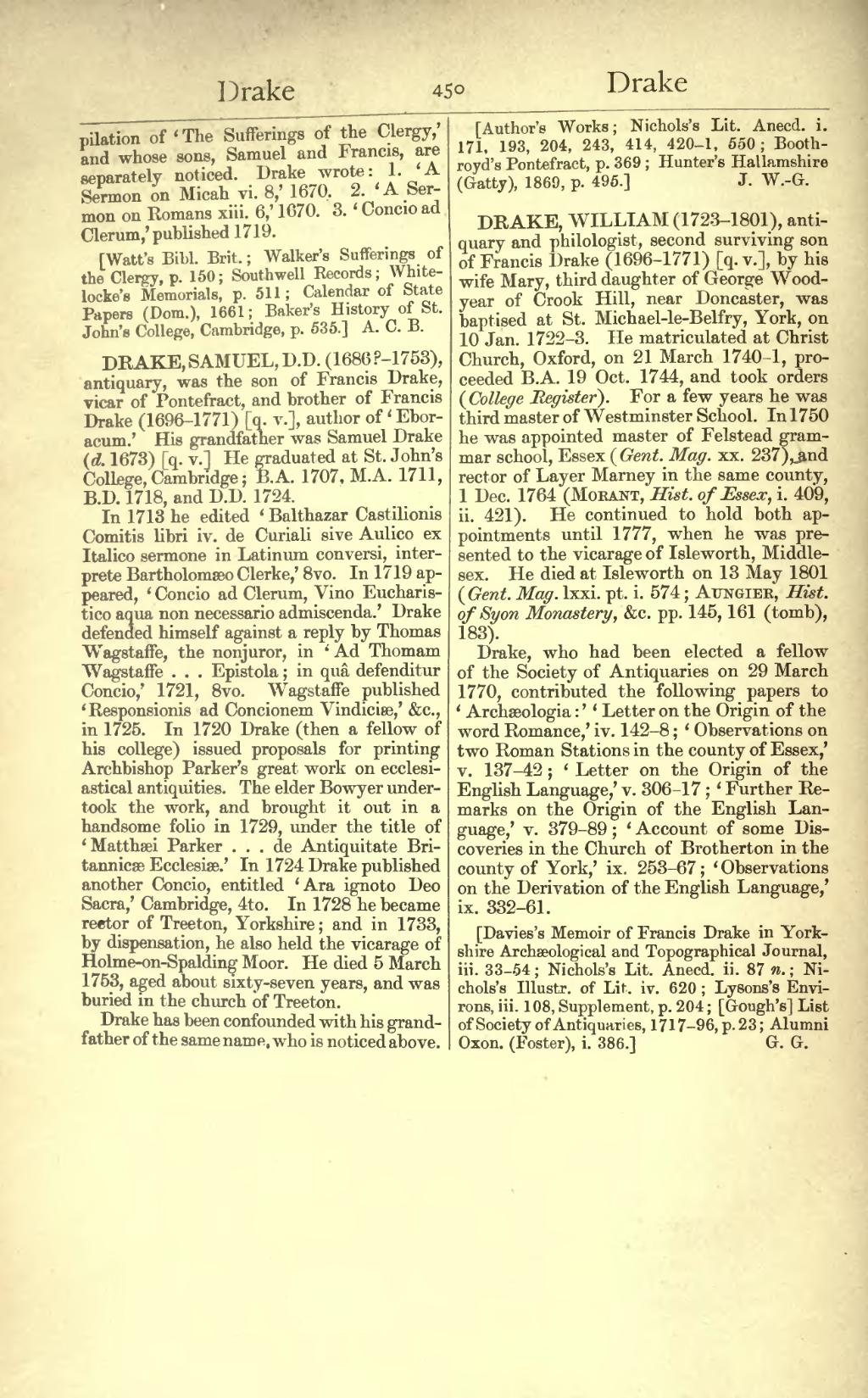pilation of 'The Sufferings of the Clergy,' and whose sons, Samuel and Francis, are separately noticed. Drake wrote: 1. 'A Sermon on Micah vi. 8,' 1670. 2. 'A Sermon on Romans xiii. 6,' 1670. 3. 'Concio ad Clerum,' published 1719.
[Watt's Bibl. Brit.; Walker's Sufferings of the Clergy, p. 150; Southwell Records; Whitelocke's Memorials, p. 511; Calendar of State Papers (Dom.), 1661; Baker's History of St. John's College, Cambridge, p. 535.]
DRAKE, SAMUEL, D.D. (1686?–1753), antiquary, was the son of Francis Drake, vicar of Pontefract, and brother of Francis Drake (1696–1771) [q. v.], author of 'Eboracum.' His grandfather was Samuel Drake (d. 1673) [q. v.] He graduated at St. John's College, Cambridge; B.A. 1707, M.A. 1711, B.D. 1718, and D.D. 1724.
In 1713 he edited 'Balthazar Castilionis Comitis libri iv. de Curiali sive Aulico ex Italico sermone in Latinum conversi, interprete Bartholomæo Clerke,' 8vo. In 1719 appeared 'Concio ad Clerum, Vino Eucharistico aqua non necessario admiscenda.' Drake defended himself against a reply by Thomas Wagstaffe, the nonjuror, in 'Ad Thomam Wagstaffe . . . Epistola; in quâ defenditur Concio,' 1721, 8vo. Wagstaffe published 'Responsionis ad Concionem Vindiciæ,' &c., in 1725. In 1720 Drake (then a fellow of his college) issued proposals for printing Archbishop Parker's great work on ecclesiastical antiquities. The elder Bowyer undertook the work, and brought it out in a handsome folio in 1729, under the title of 'Matthæi Parker … de Antiquitate Britannicæ Ecclesiæ.' In 1724 Drake published another Concio, entitled 'Ara ignoto Deo Sacra,' Cambridge, 4to. In 1728 he became rector of Treeton, Yorkshire; and in 1733, by dispensation, he also held the vicarage of Holme-on-Spalding Moor. He died 5 March 1753, aged about sixty-seven years, and was buried in the church of Treeton.
Drake has been confounded with his grandfather of the same name, who is noticed above.
[Author's Works; Nichols's Lit. Anecd. i. 171, 193, 204, 243, 414, 420–1, 550; Boothroyd's Pontefract, p. 369; Hunter's Hallamshire (Gatty), 1869, p. 495]
DRAKE, WILLIAM (1723–1801), antiquary and philologist, second surviving son of Francis Drake (1696–1771) [q. v.], by his wife Mary, third daughter of George Woodyear of Crook Hill, near Doncaster, was baptised at St. Michael-le-Belfry, York, on 10 Jan. 1722–3. He matriculated at Christ Church, Oxford, on 21 March 1740–1, proceeded B.A. 19 Oct. 1744, and took orders (College Register). For a few years he was third master of Westminster School. In 1750 he was appointed master of Felstead grammar school, Essex (Gent. Mag. xx. 237), and rector of Layer Marney in the same county, 1 Dec. 1764 (Morant, Hist. of Essex, i. 409, ii. 421). He continued to hold both appointments until 1777, when he was presented to the vicarage of Isleworth, Middlesex. He died at Isleworth on 13 May 1801 (Gent. Mag. lxxi. pt. i. 574; Aungier, Hist. of Syon Monastery, &c. pp. 145, 161 (tomb), 183).
Drake, who had been elected a fellow of the Society of Antiquaries on 29 March 1770, contributed the following papers to 'Archæologia:' 'Letter on the Origin of the word Romance,' iv. 142–8; 'Observations on two Roman Stations in the county of Essex,' v. 137–42; 'Letter on the Origin of the English Language,' v. 306–17; 'Further Remarks on the Origin of the English Language,' v. 379–89; 'Account of some Discoveries in the Church of Brotherton in the county of York,' ix. 253–67; 'Observations on the Derivation of the English Language,' ix. 332–61.
[Davies's Memoir of Francis Drake in Yorkshire Archæological and Topographical Journal, iii. 33–54; Nichols's Lit. Anecd. ii. 87 n.; Nichols's Illustr. of Lit. iv. 620; Lysons's Environs, iii. 108, Supplement, p. 204; [Gough's] List of Society of Antiquaries, 1717–96, p. 23; Alumni Oxon. (Foster), i. 386.]
